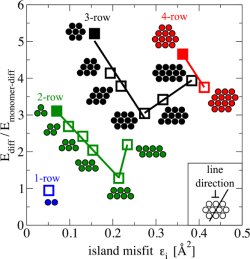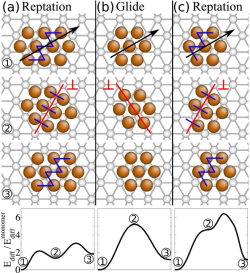Dallas R. Trinkle
Research Group
Heteroepitaxial diffusion: Cu/Ag(111)
Control of thin-film morphology relies on understanding multiple ongoing processes during deposition and growth. In particular, diffusion of small atom clusters on surfaces play a critical role in thin film growth, especially in early stages. The diffusion kinetics of small islands in heteroepitaxial systems is less well understood than that of homoepitaxial diffusion. Strain is known to govern the mesoscale morphology in self-assembling systems. While predictions about the role of size and misfit for small islands go back over a decade, only recent experiments have captured and quantified the rapid diffusion at magic sizes in the heteroepitaxial Cu/Ag(111) system. However, the experimental observations of rapid diffusion from several distinct sizes of islands does not easily comport with the simple model of Hamilton for magic sizes. A missing element in explaining the atomistic diffusion mechanism is the role of island shape in controlling diffusion. Understanding the trends of diffusion barriers for small islands with island size and shape for the common cubic (111) surface provides insight for experimental measurements and thin-film growth, and provides the fundamental understanding to control morphology.
Publications
- “Misfit-Dislocation-Mediated Heteroepitaxial Island Diffusion”
A. W. Signor, H. H. Wu, D. R. Trinkle. accepted Surface Science (2010): preprint - “Island Shape Controls Magic-Size Effect for Heteroepitaxial Diffusion”
H. H. Wu, A. W. Signor and D. R. Trinkle. J. Appl. Phys. 108, 023521 (2010): publication, PDF, doi, preprint - “Cu/Ag EAM Potential Optimized for Heteroepitaxial Diffusion from ab initio Data”
H. H. Wu and D. R. Trinkle. Comp. Mater. Sci. 47, 577-583 (2009): publication, PDF, doi, preprint
This work is in collaboration with John Weaver and Andrew Signor at UIUC, and is funded the NSF DMR division and in part by the Untenured Faculty grant from 3M. Computational resources are provided through the Turing cluster at UIUC and with a grant from Intel.


